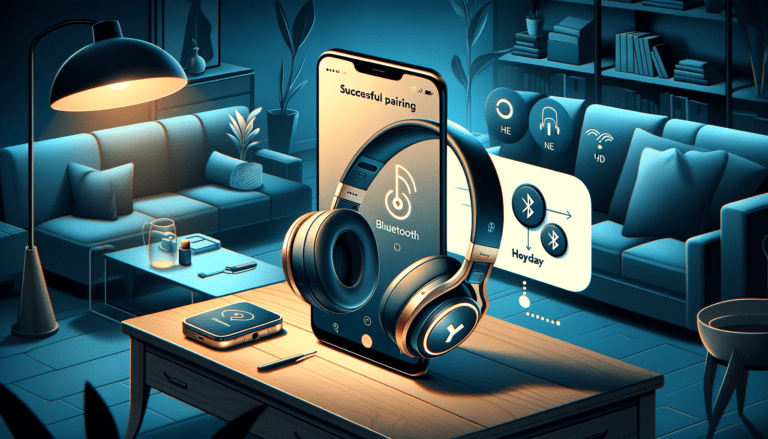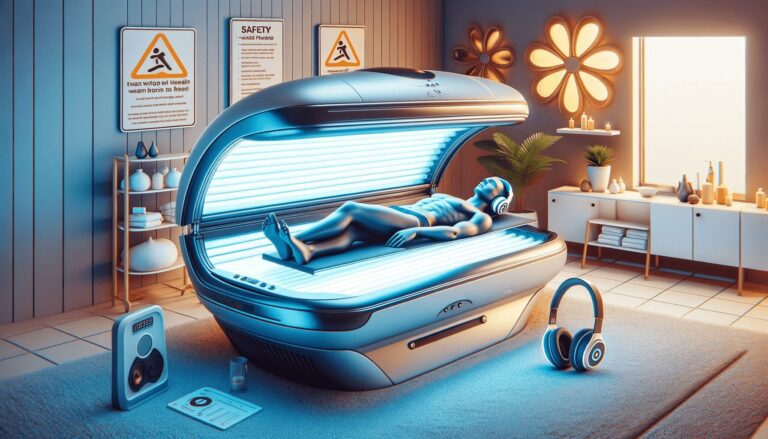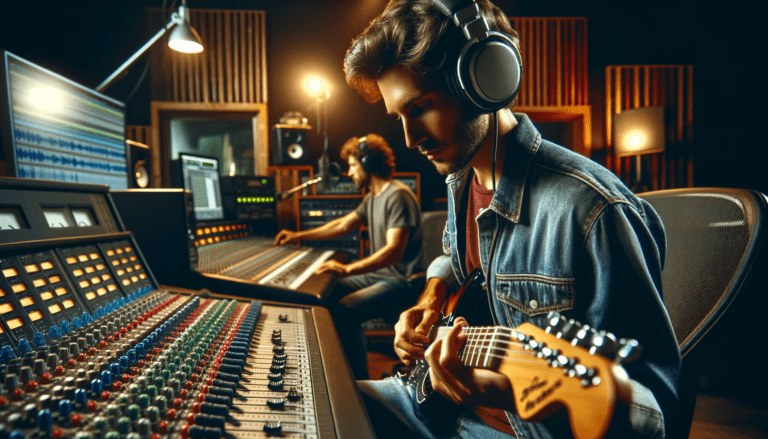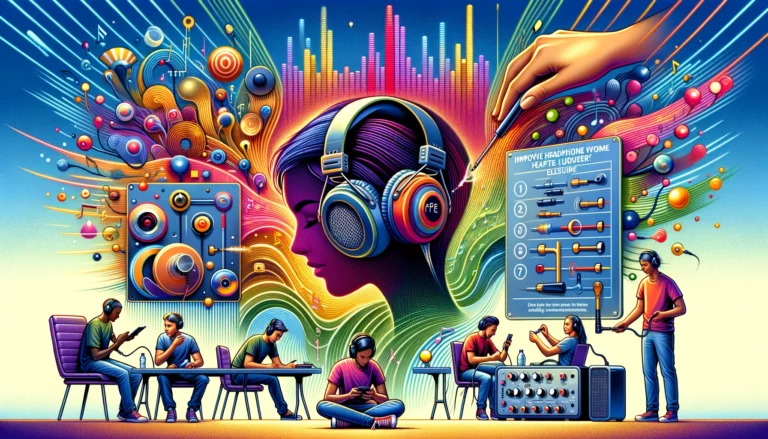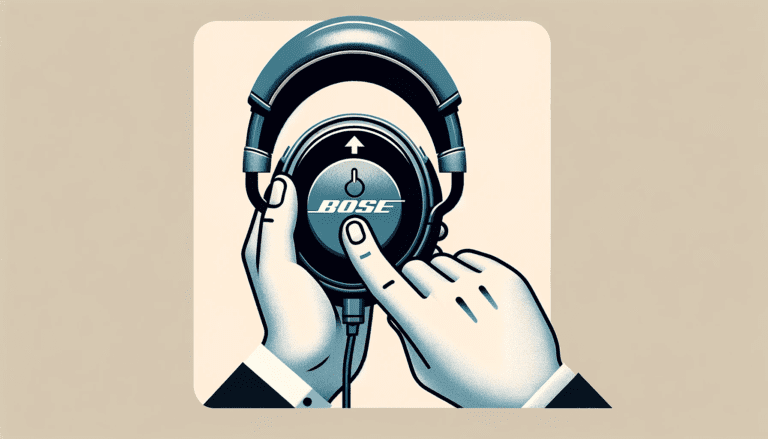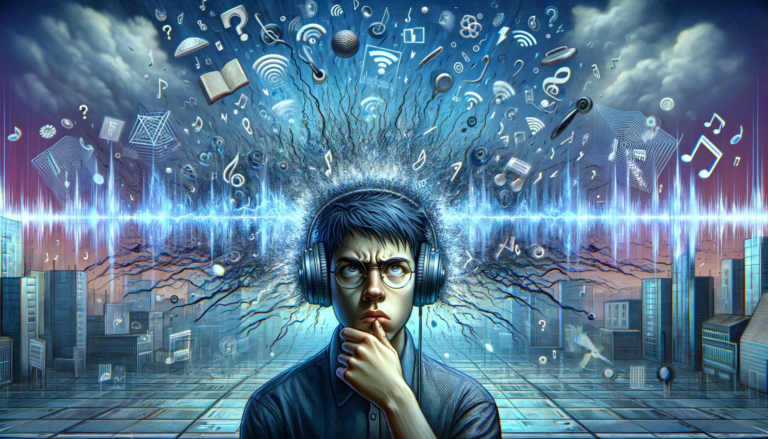Have you ever wondered why DJs are almost always seen with headphones? This isn’t just a fashion statement or a habit without reason. In the dynamic and intricate world of music mixing and live performances, DJs face a unique challenge: managing and blending multiple tracks seamlessly in a loud environment. This task, crucial to their performance, is often misunderstood or overlooked by the audience.
The answer lies in their need for precise control and synchronization of music. DJs use headphones to isolate one track while another plays through the speakers, allowing them to prepare and sync the next track flawlessly. This technique, known as cueing, is essential for a smooth transition without disrupting the flow of music. In this article, we’ll dive deeper into this aspect, exploring how headphones help DJs master the art of mixing, ensuring every beat and tune aligns perfectly with the audience.
The Mystery Behind DJ Headphones
Have you ever wondered why DJs seem inseparable from their trusty pair of headphones? It may appear peculiar at first glance – after all, they often perform in loud venues with powerful sound systems that can overpower most external noises. However, these headphones serve as more than just a stylish accessory or a tool for monitoring what’s happening on stage.
When you see a DJ sporting headphones perched stylishly on their head or engulfing their ears like earmuffs facing inward towards blissful isolation from the outside world – know that there is a method behind this seemingly fashionable madness. The primary purpose of these headphones is to assist with beatmatching – one of the fundamental skills in DJing.
Beatmatching involves lining up the tempos and rhythms of two or more tracks so that they seamlessly blend into one another. DJs rely on their ears to detect the precise moment when two beats align, ensuring that transitions between songs are smooth and harmonious.
So, in essence, those headphones act as a DJ’s aural compass, allowing them to hear both the track currently playing on the main speakers and the one they are preparing to bring into the mix. This enables them to match beats accurately and seamlessly transition from one song to another, maintaining a consistent groove that keeps everyone dancing. You may read also Why Do Autistic People Wear Headphones
The Importance of Beatmatching
Unleashing the Power of Beatmatching
Picture this: you’re at a club, surrounded by a pulsating crowd eagerly awaiting the next wave of electrifying music. As a DJ, your ability to seamlessly blend tracks is what keeps the energy flowing and the dancefloor alive.
This is where beatmatching steps onto the stage with its undeniable significance in DJing. Beatmatching is the art of synchronizing the beats per minute (BPM) of two or more songs to create a smooth transition between them.
It forms the foundation upon which DJs build their sets, allowing them to seamlessly blend different genres and eras, taking listeners on an exhilarating musical journey. By matching beats precisely, DJs maintain a continuous flow without jarring transitions or awkward pauses that could ruin an otherwise epic night.
The Role of Headphones in Precision
So how do headphones come into play? Well, they are an essential tool in a DJ’s arsenal that allows them to accurately match beats between songs.
When mixing tracks, it’s crucial for DJs to carefully listen and compare BPMs, ensuring they are in perfect sync before introducing new elements into their set. Wearing headphones provides DJs with an intimate auditory experience that enables them to focus solely on both incoming and outgoing tracks.
By isolating themselves from external noise distractions – like overenthusiastic dancers or clamoring bar chats – DJs can concentrate fully on aligning beats with precision. This meticulous attention ensures flawlessly timed transitions that keep the crowd moving with uninterrupted enthusiasm.
Headphone Monitoring: The DJ’s Secret Weapon
But beatmatching isn’t solely about aligning tempos; it also involves harmonizing elements like phrasing and song structures. These aspects contribute significantly to creating fluid mixes that captivate listeners throughout their musical odyssey on the dancefloor. With headphones, DJs can cue up specific points in a track, allowing them to preview and analyze its structure before introducing it to the mix.
By doing so, they can identify the ideal moment to blend songs seamlessly, aligning not only beats but also melodies and vocals. This level of meticulous preparation guarantees that each transition is harmonically pleasing and maintains a consistent energy flow that keeps dancers blissfully lost in rhythm.
Headphones: DJs’ Trusted Companions
The reliance on headphones for beatmatching extends beyond their technical advantages. They become an extension of the DJ’s artistic expression and an intrinsic part of their workflow.
Familiarity with headphones allows DJs to develop their unique style and signature techniques by leveraging the precise auditory feedback they provide. Furthermore, as DJ culture has evolved, headphones have also become fashion statements and symbols of status among artists.
Renowned headphone brands collaborate with top DJs, producing limited-edition models tailored to both aesthetics and professional requirements. These collaborations not only enhance the DJ’s image but also provide enhanced comfort, durability, and sound quality – essential aspects when hours-long sets are at stake.
In this grand dance between beats and harmonies, headphones serve as an invaluable asset for DJs striving for seamless mixes that mesmerize audiences. With their ability to accurately match beats between songs while offering precision monitoring capabilities, these trusty companions help shape unforgettable nights on dance floors worldwide. You may read the guide on Can I Wear Headphones Over Glasses
Cueing and Previewing Tracks
The Power of Cue Points
When it comes to creating a seamless mix, DJs rely on their ability to cue and preview tracks. Cue points are like little bookmarks that allow DJs to jump to specific moments in a song instantly.
These moments are often marked by significant beats, breakdowns, or drops that can be used to create smooth transitions between tracks. By setting cue points strategically, DJs can plan their mixes more effectively and ensure that the timing is just right.
Preparing for the Perfect Mix
Before a DJ plays a track for the crowd, they need to know what they’re getting into. This is where headphones come into play.
With their trusty headphones on, DJs can preview a track without letting it blast through the speakers for all to hear. They can quickly listen to different sections of the song, assess its energy level, identify potential mixing points, and get a feel for how it fits with the overall vibe of their set.
The Art of Beatmatching
One key aspect of previewing tracks with headphones is beatmatching. Beatmatching involves aligning the beats of two songs so that they seamlessly flow together without any jarring tempo changes or mismatched rhythms.
By listening closely through their headphones, DJs can find matching beats between two tracks and adjust one or both songs’ tempos accordingly using pitch controls on their equipment. Beatmatching is an art form in itself – it requires keen ears and precise timing.
The headphone allows DJs to focus solely on these intricate details without any external distractions getting in the way. They can precisely analyze each beat’s timing and make minute adjustments until everything syncs up perfectly.
A Sneak Peek for Crowd Pleasing
Apart from technical purposes, previewing tracks through headphones also serves as an opportunity for DJs to gauge the crowd’s response before playing a new song. They can test the waters, so to speak, by playing snippets of a track and observing the audience’s reaction. If they notice people bobbing their heads, tapping their feet, or showing signs of excitement while listening privately through their headphones, it gives them confidence that the track will be well-received when played aloud.
In addition to cueing and previewing tracks for mixing purposes, DJs also use headphones during live performances for various other reasons. From monitoring sound quality and levels to communicating with sound technicians or other DJs on stage, these humble audio devices play a crucial role in ensuring smooth and engaging DJ sets.
Remember that wearing headphones is not just a fashion statement for DJs; it’s an essential tool that helps them deliver unforgettable experiences on the dancefloor. So next time you see a DJ rocking those cans on their head, appreciate the meticulous work they’re doing behind the scenes to bring you those mind-blowing beats. You may check also Why Do Musicians Wear Headphones
Monitoring Sound Quality and Levels
The Quest for Perfection: Maintaining Consistent Sound Quality
When it comes to DJing, sound quality is the holy grail. DJs strive for crisp, clear, and consistent audio throughout their entire set.
Whether they’re playing at a small club or a massive festival, the audience expects nothing less than perfection. This is where headphones become an essential tool in a DJ’s arsenal.
Headphones to the Rescue: Monitoring Audio Levels Like a Pro
Imagine this: you’re in the middle of an intense DJ set, the crowd is cheering, and your heart is pounding with excitement. Amidst all this chaos, you need to ensure that your audio levels are spot on.
This is where headphones come into play. DJs wear headphones to closely monitor the levels of each track they play.
By keeping one ear cup on while mixing, DJs can accurately assess the volume of both tracks they are blending. They can listen carefully to each element of their mix — from basslines to vocals to snare hits — ensuring that no sound gets lost or overpowers others.
Mastering EQ: Sculpting Sounds with Precision
Equalization (EQ) is another crucial aspect of DJing that requires precision and control over audio frequencies. With headphones on, DJs can meticulously sculpt the soundscape by adjusting EQ settings for individual tracks.
They can isolate specific frequencies using EQ knobs on their mixer while simultaneously monitoring how those adjustments impact the overall mix through their headphones. This enables them to eliminate muddiness in bass frequencies or brighten up high-end elements with finesse.
Add Effects Like Magic: The Headphone Wizardry
Aside from maintaining consistent sound quality and controlling EQ, DJs often use various effects such as reverb, delay, or filters to enhance their mixes creatively. Headphones allow them to preview how these effects will impact the track before introducing them to the main sound system. By listening through headphones, DJs can experiment freely with different effects, fine-tuning their settings and seamlessly integrating them into the mix.
This ensures that the effects enhance the music rather than overpower it, creating a captivating auditory experience for the audience. Headphones serve as an indispensable tool for DJs when it comes to monitoring sound quality and levels during performances.
They enable DJs to maintain a consistent audio experience throughout their set by accurately assessing volume levels, sculpting sounds with precision through EQ adjustments, and experimenting with effects before unleashing them on the crowd. So next time you see a DJ sporting those iconic cans on their head, remember they are not just fashion accessories but powerful devices that elevate their artistry.
Isolation from External Noise
When it comes to crafting the perfect mix, DJs need an environment free from distractions. Think about it – imagine you’re in the middle of a mind-blowing drop, and suddenly someone spills their drink on your turntable.
Disaster, right? That’s why DJS must have a quiet space where they can fully immerse themselves in their music.
By wearing headphones, DJs can isolate themselves from the external noise and chaos of the crowd. The roaring applause, laughter, and chatter of club-goers can make it challenging for a DJ to focus on their mix.
But with a trusty pair of closed-back headphones covering their ears, they can block out the noise pollution effortlessly. Closed-back headphones are designed with sealed cups that prevent sound leakage.
This means that not only does the music being played directly into the DJ’s ears remain crisp and clear, but also any external noises are kept at bay. Imagine attending a concert or festival where you’ve paid good money to hear your favorite DJ perform live.
You want to experience every beat drop and bassline without any disruptions or interruptions from surrounding conversations. Well, DJs feel the same way!
They want you to enjoy their set as intended without any disturbances from outside commotion. By wearing headphones that provide isolation from crowd noise, they ensure that you receive an uninterrupted musical journey.
Moreover, blocking out external sounds also helps DJs maintain focus on beatmatching and transitions between tracks. These skills require precision timing and concentration; any distractions could lead to awkward mixes or dissonant harmonies that could ruin the overall experience for both the DJ and their audience. You may read the ultimate guide on Why Do Podcasters Wear Headphones
How closed-back headphones provide isolation from crowd noise
Closed-back headphones play a crucial role in helping DJs achieve isolation from crowd noise because of their unique design. Unlike open-back headphones, which allow sound to leak in and out of the ear cups, closed-back headphones are built with sealed ear cups that create a barrier between the DJ’s ears and the surrounding environment. These closed-ear cups effectively block out ambient noise, ensuring that DJs can focus solely on their mix.
Whether it’s the energetic cheers from the crowd or the conversations happening nearby, closed-back headphones create a sonic cocoon for DJs, helping them tune out distractions and immerse themselves in their music. Besides providing physical isolation from external noise sources, closed-back headphones often feature high-quality sound insulation materials.
These materials are carefully selected to absorb and dampen sounds from entering or escaping the earcups. This further contributes to enhancing audio clarity for DJs by minimizing any interference from background noise.
Additionally, many professional-grade closed-back headphones come equipped with thick cushioning around the ear cups. This not only adds comfort during long sets but also helps create an effective seal around the ears, preventing sound leakage and optimizing isolation even further.
Communication with Sound Technicians or Other DJs
Clear communication during live performances or collaborations
As DJs take the stage, they are not alone in their endeavors. They often collaborate with sound technicians, fellow DJs, or even vocalists. In such situations, effective communication becomes crucial to ensure seamless transitions and a memorable performance.
Headphones play a pivotal role in facilitating this communication process. When it comes to live performances, DJs use headphones as a means to communicate with sound technicians.
These technicians are responsible for managing the audio levels and ensuring that the music sounds perfect in every corner of the venue. By wearing headphones, DJs can communicate their preferences directly to these professionals.
Whether it’s requesting adjustments to equalization (EQ) settings or signaling for changes in volume levels, headphones allow for clear and discreet communication without interrupting the flow of music. Moreover, when collaborating with other DJs on stage or during back-to-back sets, headphones serve as a medium of non-verbal communication.
By utilizing hand signals or subtle movements of the head while wearing their trusty headphones, DJs can coordinate beatmatching and smoothly transition between tracks without missing a beat. This synchronized collaboration not only enhances the overall performance but also showcases the artistry involved in DJing.
Style and Branding
DJs have always been trendsetters in both music and fashion realms. Headphones have become an essential accessory that not only contributes to their professional needs but also serves as a fashion statement. The right pair of headphones can elevate a DJ’s style and enhance their overall image on stage.
DJs are known for their attention-grabbing aesthetics, from flashy outfits to elaborate hairstyles. Headphones add another layer of visual intrigue – they are an extension of their brand.
Sleek designs, vibrant colors, and eye-catching logos make these devices as much about style as they are about functionality. When it comes to popular headphone brands among professional DJs, there are numerous contenders in the market.
Brands like Pioneer, Sennheiser, Audio-Technica, and Technics have gained recognition for their exceptional sound quality and durability. Each brand offers a range of models catered specifically to the needs of DJs, allowing them to find the perfect combination of style and performance.
Evolution of DJ Headphones
DJ headphones have come a long way since their inception. The history of DJ headphones can be traced back to the early days of vinyl spinning, where DJs required sturdy and reliable devices.
Over time, advancements in technology have revolutionized these audio accessories. Early DJ headphone models were characterized by robust construction, large ear cups for noise isolation, and coiled cables that provided flexibility during performances.
As technology progressed, modern DJ headphones now incorporate features such as detachable cables for convenience and improved portability. Furthermore, technological advancements have led to the integration of wireless capabilities in some models.
This allows DJs greater freedom to move around on stage without being tethered by cables. Additionally, many DJ headphones now include noise-canceling features to eliminate distractions from external sounds.
Lesser-Known Facts about DJ Headphones
While most people recognize DJ headphones as essential tools for mixing music in clubs or festivals, there are intriguing lesser-known facts about these audio devices. For instance, did you know that renowned DJs like Carl Cox and Armin van Buuren prefer specific headphone models tailored to their unique preferences?
These personal choices often stem from a combination of sound quality, comfort during long sets, and durability. In addition to personalized preferences among famous DJs’ choices in headphones lies a realm of specialized designs that cater specifically to certain genres or techniques.
Some specialized DJ headphone models feature built-in amplifiers or extended frequency response ranges designed for accurate reproduction of bass-heavy music. Others incorporate swiveling ear cups for easy single-ear monitoring, ideal for DJs who prefer to cue tracks with one ear while listening to the main sound system with the other.
Conclusion
Headphones are not merely a stylish accessory for DJs; they serve a multitude of purposes. From facilitating clear communication with sound technicians or fellow DJs during live performances to making a fashion statement on stage, these devices are indispensable.
The evolution of DJ headphones showcases how technology has enhanced their functionality and portability over time. Lesser-known facts about DJ headphones reveal the personalized choices made by famous DJs and the availability of specialized designs tailored to specific needs.
So next time you see a DJ rocking their signature pair of headphones, remember that they are more than just an accessory – they are an integral part of their craft and style.


